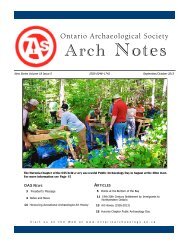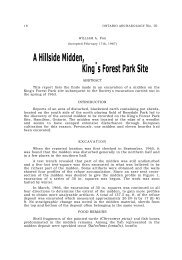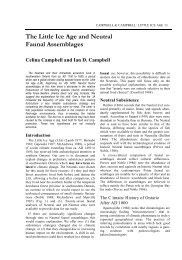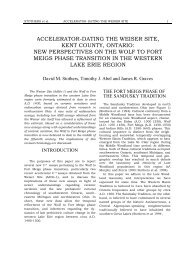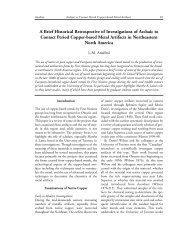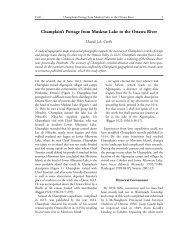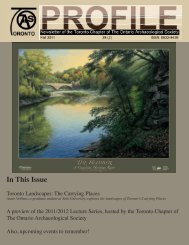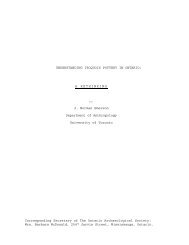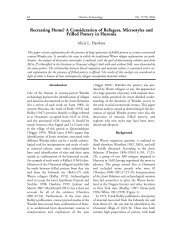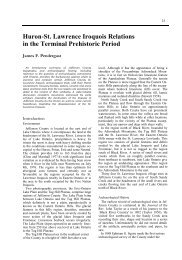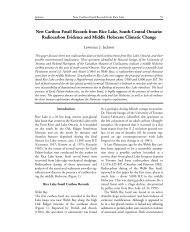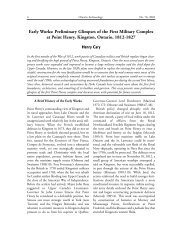OA 70 part 1 curtis & latta - Ontario Archaeological Society
OA 70 part 1 curtis & latta - Ontario Archaeological Society
OA 70 part 1 curtis & latta - Ontario Archaeological Society
Create successful ePaper yourself
Turn your PDF publications into a flip-book with our unique Google optimized e-Paper software.
Curtis and Latta Ceramics as Reflectors of Social Relationships 1Ceramics as Reflectors of Social Relationship:The Auger Site and Ball Site CastellationsJenneth E. Curtis and Martha A. LattaCeramic castellations are distinctive components of Iroquoian ceramic assemblages. The recovery of substantialnumbers of castellations from two early seventeenth century Huron village sites, Auger and Ball,provides the opportunity to investigate this class of artifact more closely. A series of attributes are defined forthe analysis of castellations and are used to characterize and compare artifacts from the Auger and Ball sites.These comparisons are facilitated by the use of the chi-square test and the coefficient of similarity. The testsreveal a high degree of similarity between the two assemblages. The relationship between the Auger andBall sites is placed within a wider context through comparisons with other sites from Huronia, along withconsideration of tribal affiliations and village relocation. This analysis indicates the relocation of a singlecommunity from the Ball site to the Auger site.IntroductionOver the last thirty years, excavations at Huronvillage sites in <strong>Ontario</strong> have recovered largequantities of ceramics. Many of these ceramicsherds exhibit projections of the vessel rimknown as castellations. Emerson (1955:2)remarked that “perhaps no single feature ofceramics is more characteristic and diagnostic ofan Iroquoian vessel” than the castellation, yetvery little attention has been given to their study.MacNeish (1952) included some information oncastellations from six sites of the contact periodHuron and Petun and their precontact predecessors,in his study of Iroquoian pottery types. Heidentified three types of castellation: pointed,bifurcated and squared. MacNeish seriated thesites according to these types, concluding thatpointed forms occur early in the sequence whilesquared forms dominate by contact period times.A type classification of castellations for the<strong>Ontario</strong> Iroquoians was developed by Emerson(1955). Like those of MacNeish (1952),Emerson’s castellation types were based on shape,as he determined that the limited number ofcastellation forms makes their morphology agood diagnostic trait. On the other hand, heobserved that the decorative designs occurringon the castellations “are so numerous as to virtuallydefy classification” (Emerson 1955:2).Emerson’s types ranged from the “Classic Early”castellation through high collared and multiplevarieties to the “Turret” type dominant in thecontact period. A<strong>part</strong> from these investigationsby MacNeish and Emerson, consideration ofcastellations has been limited to short descriptivesections or tables included in larger site reports(e.g., Busby 1979; Latta 1976; Ramsden 1989)or more general ceramic analyses (e.g., Pearce1978; Pendergast 1973). The recovery of assemblageswith large numbers of castellations fromthe Auger and Ball sites provides an opportunityto undertake both a more detailed investigationand an intersite comparison of this distinctiveartifact form.The Auger and Ball sites are located in northernSimcoe County, <strong>Ontario</strong>, between LakeSimcoe and Georgian Bay, on opposite sides ofthe Coldwater River (Figure 1). These two sitesare separated by just four kilometres. Excavationsat the Auger site were carried out over elevenyears as the Wilfrid Auger Memorial Field Schoolof the University of Toronto under the directionof Martha Latta and Gary Crawford. The Ballsite has been completely excavated by DeanKnight and the Wilfrid Laurier University fieldschool. Both sites are palisaded Huron villagesconsisting of numerous closely packed longhousesand middens (Knight 1978; 1987; Latta1985a). The Ball site dates to circa A. D. 1600
2 <strong>Ontario</strong> Archaeology No. <strong>70</strong>, 2000NSevern SoundCHARLEBOISROBITAILLENottawasagaW y eR ive rH o gC r e ekR ive rBIDMEADBayORRLAKESturgeonTHOMSON-WALKERAUGERColdwaterR i v e rBALLWARMINSTERBASSLAKE5 0 510 kmFigure 1. The location of the Huron sites from which castellations were analyzed for this study.(Knight 1978:53) and the Auger site to circa A.D.1610-1630 (Latta 1985a). Ceramic vessel sherds,including castellations, constitute the most abundantclass of artifact recovered from these sites.This study focuses on an attribute analysis andsubsequent comparison of the castellations fromthese sites. While the typological approach usedby Emerson (1955) provided a good introductionto castellation forms and identified bothtemporal and geographical variation in theirmanufacture, several problems are evident in hisclassifications. For example, while he labeled onetype “Turret” his “Grooved” and “Notched”types included mostly turret-shaped varieties.Emerson’s illustration of the “Incipient Turret”type (1955:Figure 9b) shows a notched castellationas does his illustration of the “Grooved” type(1955:Figure 10a). These problems, inherent inthe type approach, are reduced through the useof attribute analysis which allows characteristicssuch as shape, grooving and notching to be consideredindividually (Engelbrecht 1980). In thisstudy, attributes are defined for aspects of castellationshape, decoration and paste in order toelicit information regarding the potters’ conceptsof what constitutes a castellation and to facilitatecomparisons between the Auger and Ball assemblages.These comparisons focus on the characterand degree of similarity between the assemblages.The results of this analysis indicate a close resemblancein all aspects, which is evaluated in twoways. First, the possibility that this similarityreflects membership of the Auger and Ball communitiesin the same tribal group is consideredthrough comparison with other Huron villages.Second, the possibility that the close resemblancerepresents the relocation of a single communityas recorded in ethnohistoric accounts is evaluated.As will be shown, the high degree of similaritybetween the Auger and Ball assemblages doesindicate the relocation of a single Huron communityover time from Ball to Auger.
Curtis and Latta Ceramics as Reflectors of Social Relationships 3The Auger and Ball CastellationsThe Auger assemblage consists of 513 castellationswhile the Ball assemblage consists of 996castellations from which a random sample of 500was selected for analysis. Four metric attributesof shape were recorded: the height of the castellationmeasured from the base of the collar to itshighest point; the width of turret-shaped castellationsmeasured from corner to corner at thetop; the slope of each side of the castellationmeasured by recording the amount of rise overone centimetre of distance along the rim fromthe edge of turret and double-shaped castellationsand from the centre of pointed and roundcastellations; and the thickness of the lip measuredin the centre of each castellation.The mean, standard deviation and range werecalculated for each of these attributes (Table 1).It should be noted, however, that due to the factthat some of the castellations are incomplete, notall attributes could be determined for every specimen.This has resulted in different sample sizesfor each attribute category. These results werecompared using the two-sample means test andthe equality of variances test (Burt and Barber1996). The variances of all the measured attributesare equal and the two assemblages are indistinguishablein terms of mean slope and lipthickness. The mean height of castellations fromthe Auger site is 2.9 cm and from Ball is 3.1 cm.The equality of means test indicated that thesemeans are different, however, the variances of thetwo samples are equal. The mean width of turretcastellations is also different with a mean of 1.8cm at Auger and 2.0 cm at Ball. The variances inwidth are equal. Though the means for heightand width are different, this difference is slightwith the castellations from Ball being a littlehigher and wider than those from Auger. Themean slope of castellation sides is equal for boththe left slope at 0.8 cm and the right slope at 0.9cm. The variances are also equal for left and rightslopes. The mean lip thickness for both assemblagesis 0.8 cm. Again, the means and variancesare equal. There is thus a high degree of similarityin the dimensions of the castellations fromthe Auger and Ball sites.Most attributes, however, were recordable onlyat a categorical level of data. These attributeswere compared first in terms of the presence orabsence of each attribute at each site. Second, thefrequency of occurrence of each attribute statewas compared between the two sites. The similarityof attribute state frequencies was testedusing both a chi-square test (Burt and Barber1996) and a coefficient of similarity (Brainerd1951; Robinson 1951). The chi-square test evaluatesthe hypothesis that the two assemblages areidentical in terms of attribute state frequencies bycomparing the observed frequencies with thosethat would be expected in the event that thehypothesis is correct and the assemblages areidentical. If the test shows no significant differenceTable 1. Measured attributes of the castellations from theAuger and Ball sites.Auger BallHeight (cm)mean 2.9 3.1standard deviation 0.9 0.9maximum 5.9 5.9minimum 0.8 1.2range 5.1 4.7n 310 359Width (cm) [Turrets only]mean 1.8 2.0standard deviation 0.7 0.8maximum 4.6 5.1minimum 0.5 0.3range 4.1 4.8n 240 264Left Slope (cm)mean 0.8 0.8standard deviation 0.4 0.4maximum 2.5 2.0minimum 0.1 0.1range 2.4 1.9n 269 331Right Slope (cm)mean 0.9 0.9standard deviation 0.5 0.4maximum 2.0 2.0minimum 0.1 0.1range 1.9 1.9n 286 330Lip Thickness (cm)mean 0.8 0.8standard deviation 0.2 0.2maximum 1.9 1.8minimum 0.3 0.4range 1.6 1.4n 395 427
4 <strong>Ontario</strong> Archaeology No. <strong>70</strong>, 2000between the observed and expected frequenciesat a predetermined confidence level, then thehypothesis is supported. If, on the other hand,the test shows a significant difference betweenthe observed and expected frequencies, then thetwo assemblages cannot be considered to beidentical in terms of the attribute tested. Thecoefficient of similarity measures the degree ofsimilarity between two assemblages by calculatingthe total amount of disagreement betweenthem in terms of attribute state frequencies. Iftwo assemblages are identical they will have acoefficient of similarity of 200; the closer thiscoefficient is to 200, the greater the similaritybetween the assemblages (Robinson 1951). Thismeasure was designed for use with ceramic typefrequencies, but can also be applied to attributefrequencies (Bursey 1993; Ramsden 1977). Thisresults in a coefficient for each attribute. Theresults of these tests are described below.All of the castellations from both sites are grittemperedand the composition of this temperingvaries similarly in both assemblages. Some sherdsare predominantly mica-tempered, others arequartz-tempered. A combination of mica andquartz–or more rarely mica, quartz and othersubstances such as feldspar–are also present. Thefrequencies of these various temper compositionsvary somewhat between the assemblages as indicatedby the chi-square test and a coefficient ofsimilarity of 177.77. The chi-square value of27.46 with three degrees of freedom shows a significantdifference between the assemblages at a99 percent confidence level. They do, however,have the same rank order from most to leastcommon: quartz and mica, mica only, quartzonly, or mixed. Thus, potters from both sitesconsidered quartz and mica to be appropriate foruse as temper.The size of temper <strong>part</strong>icles, recorded on a relativescale compared to the assemblages as awhole, as either “small”, “medium”, or “large”, isvery similar between the two assemblages. Eachsample consists of 40 to 50 percent of vesselsconstructed from fabric containing small temperand 40 to 50 percent containing medium temper.A chi-square test was unable to distinguishany difference at a 99 percent confidence level.Its value is 2.27 with two degrees of freedom.The coefficient of similarity is 190.52. Theamount of temper used, also categorized as“small”, “medium” or “large” is closely similar.Once again small and medium amounts eachmake up 40 to 50 percent of each assemblage. Achi-square test with a value of 4.18 and twodegrees of freedom found no difference betweenthe assemblages at a 99 percent confidence leveland the coefficient of similarity is 188.58. Thepotters from both sites thus made similar choicesregarding the size and amount of temper used.The attribute of paste consistency is an evaluationof how well the paste holds together. Awell-knit paste has a uniform consistency anddoes not exhibit any cracks, whereas a laminatedpaste contains layered cracks parallel to thecastellation surfaces and a crumbly paste cracksin a <strong>part</strong>iculate pattern. These three categories ofpaste consistency are present in both assemblagesin very similar frequencies. The majority of thecastellations from Auger (63.01 percent) and Ball(58.23 percent) are well-knit, while the remainderare laminated or more rarely crumbly. A chisquarevalue of 2.98 with two degrees of freedomshows no significant difference between the twoassemblages at a 99 percent confidence level anda coefficient of similarity of 190.44 confirms thisresult.Four basic castellation shapes: pointed, round,turret and double are present at both Auger andBall (Figure 2). Turrets are predominant at bothsites and their frequency is nearly identical:79.16 percent at Auger and 79.36 percent atBall. The double shape is equally rare at bothsites. Round and pointed castellations differslightly in frequency: 15.63 percent are round atAuger versus 11.93 percent at Ball, while 4.71percent are pointed at Auger versus 8.26 percentat Ball. The rank order of shape frequencies,from greatest to least, is the same for both sites:turret, round, pointed, double. A chi-square testwith a value of 6.12 and two degrees of freedomwas unable to find a significant differencebetween the frequencies of castellation shape inthe two assemblages at a 99 percent confidencelevel. This indicates that the Auger and Ball sitecastellations are nearly identical in terms of
Curtis and Latta Ceramics as Reflectors of Social Relationships 5Figure 2. Basic castellation shapes: pointed (a), round (b), turret(c), and double (d).shape, a conclusion supported by a coefficient ofsimilarity of 192.51. The potters from both siteswere not only choosing to use the same shapes andthus create a similar visual impression, but theywere also choosing them with the same frequency.Both the Auger and Ball assemblages containthe same four interior rim shapes: straight, concave,convex and pinched. Concave interior rimsdominate the assemblages with similar frequenciesof 78.47 percent at Auger and 80.60 percentat Ball. Other shapes also show similar frequenciesand the rank order of frequency from greatestto least is the same for both: concave, convex,straight and pinched. This apparent close similarityin interior rim shape was tested using thechi-square test. The calculated value is 3.57 withtwo degrees of freedom. At a 99 percent confidencelevel no difference is evident between theassemblages. The coefficient of similarity,194.71, for this attribute category also indicatesa very close similarity. Again, the potters fromAuger and Ball were choosing the same shapeswith the same frequency.Both assemblages include castellations withvarying degrees of outward projection from thevessel rim. The amount of projection was measuredon a scale of zero to five with zero representingno projection and five maximum projection.While most castellations project somewhat,the number of castellations in each categorydeclines as projection increases. This patternholds true for both sites. A chi-square value of6.39 with five degrees of freedom indicates nosignificant difference between the assemblages ata 99 percent confidence level, thus correspondingwith a high coefficient of similarity of 187.24.Almost all of the castellations are decoratedwith incised lines. In some cases this decorationis simply a continuation of the motif used on thecollar of the vessel, in others a different motif wasused on castellations. Both cases represent a decorativechoice made by the potter, thus the motifoccurring on the castellation was recordedregardless of whether or not it differed from thecollar motif. The incised line decorative categoryis itself further dominated by oblique lines occurringin similarly high frequencies of 77.58 percentat Auger and 82.73 percent at Ball. Thecombination of vertical and oblique lines is thenext most common pattern in both cases, comprising8.93 percent and 10.24 percent of theAuger and Ball assemblages respectively. The Ballcastellations exhibit slightly less variety in decorativemotifs than do those from Auger. The chisquaretest for this attribute does indicate a significantdifference between the two assemblagesat the 99 percent confidence level. The calculatedchi-square value is 16.77 with five degrees offreedom. Despite this difference, the coefficientof similarity remains high at 185.43. Theseresults indicate that the potters from both sitesconsidered incised lines and especially incisedoblique lines to be appropriate decoration forcastellations.A variety of patterns of oblique lines are representedat both sites. More than half the castellationsin each assemblage exhibit downwardpointing chevron motifs (Figure 3c). The frequencyof this motif is very similar with 56.94percent at Auger and 55.64 percent at Ball.Second in importance at both sites is a simpleband of oblique lines slanting upward to theright (Figure 3a), then a crossed chevron motif(Figure 3e) both also occurring in similar frequencies.The remaining patterns are equally rareat both sites. A chi-square test applied to thisdata was unable to indicate a significant differenceat the 99 percent confidence level with avalue of 9.78 and seven degrees of freedom.Close similarity between the assemblages is alsoillustrated by a coefficient of similarity of189.16. Therefore, not only are both assemblagesdominated by incised oblique lines, they alsoshow a high degree of similarity in the directionand patterning of those lines.
6 <strong>Ontario</strong> Archaeology No. <strong>70</strong>, 2000Figure 3. Oblique line motifs oncastellations. Note that 3e hasdownward-pointing chevrons appliedfirst, whereas 3i hasupward-pointing chevrons appliedfirst.Castellations from the Auger site have anywherefrom zero to four grooves, as do most ofthose from Ball, although one castellation fromBall has five grooves. Grooves were identified asthick, deep lines running vertically down the faceof the castellation. The majority of castellationsin both assemblages however, lack grooving.Once again the chi-square value of 10.85 withfour degrees of freedom shows no significant differencebetween the assemblages at a 99 percentconfidence level. The coefficient of similarity ishigh at 188.40.Notching, in the form of a series of angular orV-shaped cuts, is found on a similar minority ofcastellations in both assemblages. This attributeoccurred in several different locations on thecastellation as illustrated in Figure 4. Notchingon Auger site castellations occurs most oftenbetween grooves or vertical lines (Figure 4e)whereas on Ball site castellations it occurs mostoften on appliqué ridges (Figure 4f). This differenceappears to be due to the greater number ofcastellations in the Ball assemblage that bearappliqué ridges. Consequently, the chi-squaretest does indicate a significant difference betweenthese two assemblages in terms of notching at a99 percent confidence level with a value of 37.49and five degrees of freedom. The coefficient ofsimilarity, at 180.43, also suggests a smallamount of variation between the assemblages inthis respect. When the notching on ridges isomitted from the analysis, the assemblages showgreater similarity, yet the chi-square test still indicatesa significant difference at the 99 percentconfidence level with a value of 13.28 and fourdegrees of freedom, as both notching betweengrooves and along the collar base (Figure 4c) aremore common at Auger.In both assemblages, castellation lips are oftennotched . Continuous lip notching is fairly common,being exhibited by 28.90 percent of Augercastellations and 25.39 percent of Ball castellations.Castellations with one or a few notches inthe centre of the lip are also present. The Ball sitecastellations have slightly more notches thanthose from Auger. The chi-square test with avalue of 22.98 and six degrees of freedom–indicatinga significant difference between assemblagesat a 99 percent confidence level–and a coefficientof similarity of 176.73 both demonstratesome variability between the two assemblages.Among the castellations from Auger are fivewith distinctive horizontal gashes in the form ofFigure 4. Varieties of notching: down the centre (a), across thefront (b), at the base of the collar (c), outside grooves (d), betweengrooves (e), and on appliqué ridges (f).
Curtis and Latta Ceramics as Reflectors of Social Relationships 7long, elliptical cuts. No such decoration wasobserved on the Ball castellations. Due to thevery small number of castellations with gashes itis not possible to perform a chi-square test, however,the coefficient of similarity remains veryhigh at 198.04.Appliqué ridges are present in both assemblages,however, the Auger assemblage includesjust five fragmentary examples compared to 31in the Ball assemblage. While the coefficient ofsimilarity, 189.60, is high for this attribute categorythe chi-square test with a value of 29.42 andone degree of freedom does indicate a significantdifference at the 99 percent confidence level.A distinctive modelled face motif is equallyrare in both assemblages, occurring on less thanone percent of the castellations. The rarity of thismotif prevents calculation of the chi-squarevalue, but the similarity in frequencies is evidentand supported by an extremely high coefficientof similarity of 199.22.Both assemblages contain a small number ofcastellations bearing simple incised line decorationdirectly beneath the projection. This attributeoccurs in a higher frequency in the Ballassemblage (8.17 percent) than in the Augerassemblage (3.16 percent). Consequently, thechi-square value of 8.57 with one degree of freedomdoes indicate a significant difference at the99 percent confidence level despite a high coefficientof similarity at 189.98.A few castellations in each assemblage exhibitevidence for the attachment of small handlesdirectly below the castellation. A chi-square testwith a value of 1.40, with one degree of freedomthat shows no significant difference at the 99 percentconfidence level, along with an extremelyhigh coefficient of similarity at 197.92 indicates avery close similarity in the occurrence of handles.In summary, nine of the attribute categoriesshow no significant difference in the frequenciesof their attribute states when compared using thechi-square test. The Auger and Ball castellationassemblages are, in fact, virtually indistinguishablein terms of these attributes. Even thoseattribute categories that differ significantly,according to the chi-square tests, have high coefficientsof similarity which indicate that the differencesbetween them are not great. The coefficientsof similarity range from a low of 176.73for lip notching to a high of 199.22 for the incidenceof face motifs. The mean coefficient ofsimilarity for these two sites is 189.22.Considering that the maximum possible valuefor this measure is 200.00, this result reflects avery high degree of similarity between the twocastellation assemblages.This close similarity in attribute frequencies ispresent in all classes of attributes: shape, decorationand paste, indicating shared concepts ofcastellation form, appropriate decorative motifsand the use of similar manufacturing techniques.In addition to considering individual attributes,styles of combined attributes were investigatedresulting in the identification of commonand anomalous styles within the assemblages. Astyle is considered here to consist of a set ofattribute states that consistently co-occur.Following Davis’ (1990:19) definition of style,each individual artifact possesses most but notnecessarily all of the attribute states in the set,while each state is found in a large number of theartifacts. This approach groups together artifactsthat are similar, while still allowing room for thevariation that is present among them. In this wayit provides a more comprehensive level of analysisthan is possible when considering each attributeindividually. This concept of style is furtherdifferent from that of type as it is more flexibleand does not carry any inherently chronologicalor spatial implications. It likewise adds anotherdimension to an evaluation of the similaritybetween assemblages. Combinations of attributestates or styles that are common within an assemblagemay be identified and styles that are anomalouswithin the context of that assemblage maybe isolated. The two assemblages may then becompared in terms of these different styles.The common style is clearly the turret-shapedcastellation with oblique incised lines as it comprises80 percent of the Auger assemblage and 85percent of the Ball assemblage (Figure 5). Manyof these castellations also have attributes ofnotching, lip notching and grooving. Grooving,for example, is most often associated with theturret shape. In the Auger assemblage, 30 percent
8 <strong>Ontario</strong> Archaeology No. <strong>70</strong>, 2000Figure 5. Examples of the commoncastellation style from theAuger site.of turret-shaped castellations have grooves comparedto five percent each of round and pointedcastellations. Similarly, in the Ball assemblage 35percent of turret castellations have grooves whileonly two percent of round and three percent ofpointed castellations bear this trait. While consistingof a set of specific and limited attributes,such as turret shape, oblique incised lines andvertical grooving, which renders them a commonstyle, practically no two of these castellations areidentical. Nonetheless, these artifacts vary withinclosely restricted bounds.Interestingly, the anomalous styles withinthese two assemblages exhibit a much greaterdegree of internal consistency than the commonturret-shaped style, though this is harder to judgebased on a much smaller number of examples.One such style is that of a round castellation withhorizontal incised lines, one lip notch and notchesalong the base of the collar (Figure 6a). Foursuch castellations are present in the Auger assemblageand five occur in the Ball assemblage.MacNeish (1952:34-35) noted that this castellationstyle is often associated with rims of theWarminster Horizontal type that, as the nameimplies, are <strong>part</strong>icularly common at theWarminster site.Another distinctive anomalous style is representedby the double shaped castellation withpinched interior and incised oblique lines (Figure6b). The Auger and Ball castellation assemblageseach contain two examples of this rare style.Several castellations are decorated with facemotifs (Figure 6c). Considering that all othercastellations are decorated with incised lines ingeometric designs, this is a very unusual decoration.The face, an anthropomorphic design, representsan entirely different design category.These faces are characterized by a small lump fora nose with small incisions or gashes along side itfor eyes, eyebrows and mouth. This unusual decorationis predominantly applied to round castellations.Three castellations with face motifs wereidentified in the Auger assemblage comparedwith five in the Ball assemblage. MacNeish(1952:60) described the association of such facemotifs with a number of Onondaga-Oneidaceramic types.The few castellations at the Auger site withelliptical gashes have low round castellations onhigh collars and thus form another unusual style(Figure 6e). Witthoft and Kinsey (1959:76, 95)described and illustrated a Schultz Incised typefrom the Lower Susquehanna valley inPennsylvania that closely matches this style. Thetype is common at the contact period Schultz siteand dates to A.D. 1550-1620. MacNeish(1952:50) described a similar type, Ithaca Linear,
Curtis and Latta Ceramics as Reflectors of Social Relationships 9Figure 6. Examples of the anomalouscastellation styles from theAuger site: round with horizontallines (a), double-shaped (b), facemotif (c), appliqué ridges (d),and gashed (e).from postcontact Cayuga sites in New York, thediagnostic features of which include “large ellipticalpunch decoration [gashes] on extremelyhigh incipient collars.” Finally, a few turretshapedcastellations were decorated withappliqué ridges (Figure 6d). The ridges are verticaland oblique in form with notches runningalong them. While the form and decoration ofthese castellations is identical between the twosites, the Ball assemblage contains significantlymore of them (n=31) than does the Auger assemblage(n=5).These anomalous styles, present at both sitesare indistinguishable in form, decorationand–excluding those with appliqué ridges–in frequency,and thus indicate a very strong relationshipbetween Auger and Ball. The sharing ofcommon styles suggests that the potters at thesesites <strong>part</strong>icipated in a network of common ideasabout castellations. Identical anomalous forms inaddition to shared common styles further supporta close connection between the two sites, aswell as a common pattern of interaction withIroquoian groups to the south. Taken altogetherthis data indicates a strong similarity between thecastellations of the Auger and Ball sites.Comparison With Neighbouring VillagesOther villages dating to the proto-contact andpostcontact periods are located within a fewkilometres of the Auger and Ball sites (Figure 1).This raises the question as to whether the similaritiesobserved between Auger and Ball arecommon to all Huron sites or are indicative of a<strong>part</strong>icularly close relationship between these twosites. An examination of the castellations fromthe Thomson-Walker (n=59), Warminster(n=162), Bidmead (n=82), Robitaille (n=74)(Latta 1976), and Charlebois (n=37) (Latta 1976)sites, in comparison with those from the Augerand Ball sites places the relationship between
Curtis and Latta Ceramics as Reflectors of Social Relationships 15Pearce, R.J.1978 A Preliminary Report on the Draper Site RimSherds. Research Report 1. Museum ofIndian Archaeology, University of Western<strong>Ontario</strong>, London, <strong>Ontario</strong>.Pendergast, J.F.1973 The Roebuck Prehistoric Village Site RimSherds: An Attribute Analysis. Mercury SeriesPaper 8. <strong>Archaeological</strong> Survey of Canada,National Museum of Man, Ottawa.Ramsden, C.N.1989 The Kirche Site: A 16 th Century Huron Villagein the Upper Trent Valley. Occasional Papersin Northeastern Archaeology 1. CopetownPress, Dundas, <strong>Ontario</strong>.Ramsden, P.G.1977 A Refinement of Some Aspects of HuronCeramic Analysis. Mercury Series Paper 63.<strong>Archaeological</strong> Survey of Canada, NationalMuseum of Man, Ottawa.Robinson, W.S.1951 A Method for Chronologically Ordering<strong>Archaeological</strong> Deposits. American Antiquity16:293-301.Sagard, G.1939[1632]The Long Journey to the Country of theHurons, edited by M. Wrong. Translated byH. H. Langton. Champlain <strong>Society</strong>, Toronto.Thwaites, R.G. (editor)1959 The Jesuit Relations and Allied Documents:Travels and Explorations of the JesuitMissionaries in New France. 73 Vols. PageantBooks, New York.Trigger, B.G.1976 The Children of Aataentsic: A History of theHuron People to 1660. 2 vols. McGill-Queen’s University Press, Montreal.Tuck, J.A.1971 Onondaga Iroquois Prehistory: A Study inSettlement Archaeology. Syracuse UniversityPress, Syracuse.Warrick, G., and J. Molnar1986 An Iroquoian Site Sequence from InnisfilTownship, Simcoe County. Arch Notes86(3):21-34.Witthoft, J., and W.F. Kinsey III (editors)1959 Susquehannock Miscellany. The PennsylvaniaHistorical and Museum Commission,Pennsylvania.Jenneth E. Curtis and Martha A. LattaDe<strong>part</strong>ment of Anthropology, University of Toronto100 St. George Street, Toronto, <strong>Ontario</strong>, Canada M5S 3G3jenneth.<strong>curtis</strong>@utoronto.ca <strong>latta</strong>@scar.utoronto.ca



